일본 고객 서비스 정복: 국제적 성장을 위한 로드맵

일본으로의 진출은 국제 비즈니스에 엄청난 잠재력을 제공하지만 성공은 제품 품질이나 경쟁력 있는 가격 이상의 요소에 달려 있습니다.일본에서 고객 서비스는 단순한 운영 기능이 아니라 존중, 세심함, 조화와 같은 가치를 반영합니다.중소기업 (SME) 의 서비스 기준은 대부분의 서구 시장보다 높은 경우가 많은데, 처음에는 부담스럽게 느껴질 수 있습니다.
이 가이드에서는 일본 고객 서비스가 특별한 이유, 외국 기업이 피해야 할 일반적인 실수, 중소기업이 성공하기 위해 사용할 수 있는 실용적인 전략을 살펴봅니다.일본 소비자가 기대하는 경험을 제공하는 방법을 배우면 충성도를 높이고 평판을 보호하며 세계에서 가장 안목이 높은 시장 중 하나에서 지속 가능한 입지를 구축할 수 있습니다.
일본 고객 서비스가 글로벌 표준을 설정하는 이유
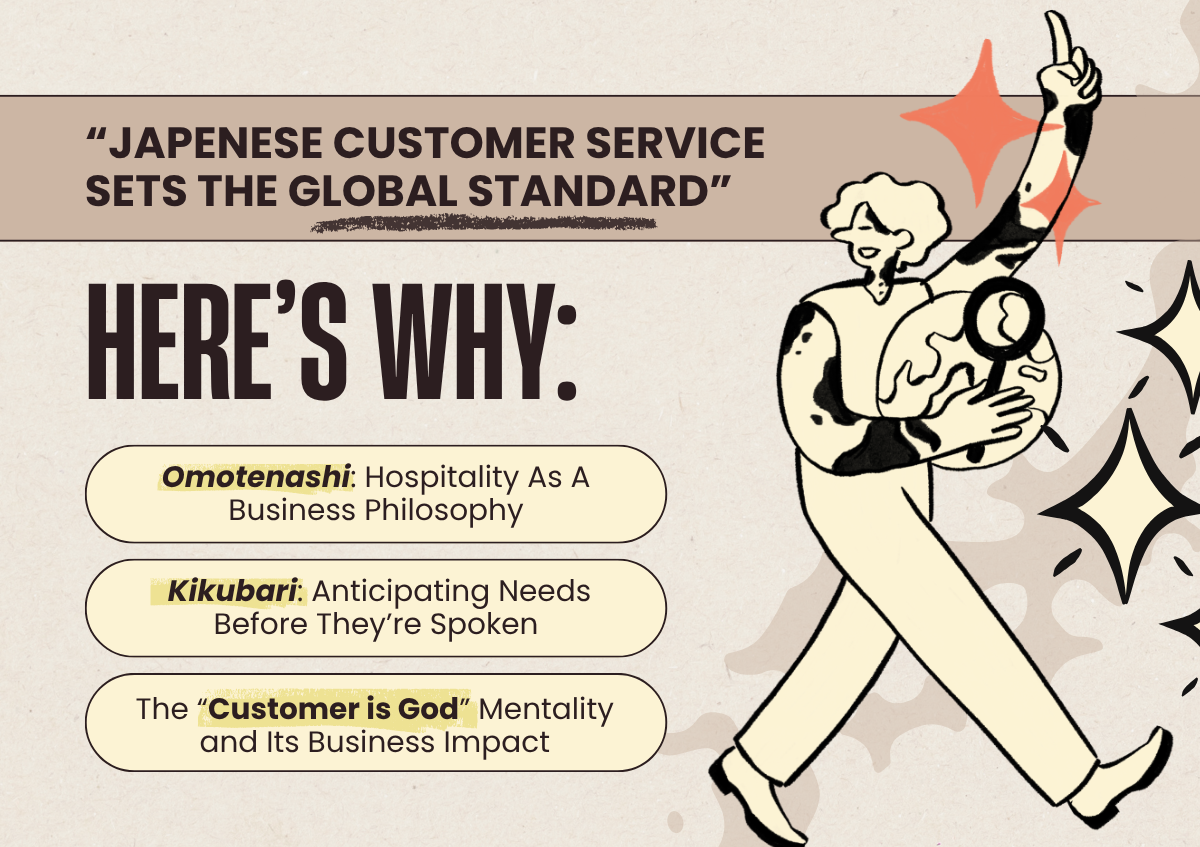
일본의 고객 서비스는 단순한 비즈니스 기능 그 이상입니다. 문화적 가치, 사회적 조화, 수 세기 동안 이어져 온 환대 전통을 반영합니다.많은 국가들이 친절하거나 효율적인 서비스를 자랑하지만, 일본의 접근 방식은 일관성과 깊이에서 독특합니다.인근 편의점부터 5성급 호텔에 이르기까지 고객들은 똑같이 높은 수준의 존중, 세심함, 배려를 받고 있습니다.
에 대한 국제 비즈니스특히 중소기업 (SME) 은 이러한 기대치를 이해하는 것이 중요합니다.미국에서는 '그 이상'으로 간주될 수 있는 것이 일본에서는 종종 기준선으로 간주됩니다.이 섹션에서는 일본 고객 서비스의 세 가지 초석인 오모테나시, 키쿠바리, 그리고 “고객은 신이다”라는 사고방식을 살펴보고 이를 서구의 관행과 비교합니다.
오모테나시: 비즈니스 철학으로서의 호스피탈리티
일본 고객 서비스의 기본은 대가를 바라지 않고 성실, 겸손, 타인에 대한 배려를 강조하는 환대 철학인 오모테나시에 있습니다.그 뿌리는 다도나 전통 여관 (료칸) 과 같은 문화적 관행으로 거슬러 올라갑니다. 이곳에서는 호스트가 실내 온도부터 차 리필에 이르기까지 손님의 모든 필요를 예상했는데, 종종 손님의 말 없이 호스트가 모든 손님의 요구를 예상했습니다.
현대 비즈니스에서 오모테나시는 세부 사항에 대한 세심한 주의를 의미합니다.입장 시 고개를 숙이거나, 저렴한 물건이라도 깔끔하게 포장하거나, 구매 후 후속 조치를 취하는 것과 같은 작은 제스처에는 모든 고객이 존중과 감사를 받아야 한다는 사고방식이 반영되어 있습니다.
미국과는 대조적입니다.
미국에서는 고객 서비스가 친절함, 효율성, “고객은 항상 옳다”라는 생각을 중심으로 구성되는 경우가 많습니다.이러한 원칙은 훌륭한 경험으로 이어질 수 있지만 일관성이 없습니다.어떤 상호 작용은 따뜻하고 능동적인 것처럼 느껴지지만, 다른 상호 작용은 트랜잭션이나 서두르는 느낌이 들기도 합니다.이에 비해 일본 서비스는 일관성을 목표로 합니다. 모든 고객은 가격대나 상황에 관계없이 동일한 수준의 서비스를 받아야 합니다.
중소기업을 위한 테이크아웃
일본의 의식을 흉내낼 필요는 없지만, 모든 상호작용을 즐거움의 기회로 여긴다는 오모테나시 사고방식을 채택하면 일본에서 브랜드를 즉시 차별화할 수 있습니다.
키쿠바리: 요구 사항을 말하기 전에 미리 예측하기
키쿠바리 (문자 그대로 “주의를 분산시키는 것”) 는 무언의 필요를 알아차리고 이에 대응하는 기술입니다.예의를 갖추는 차원을 넘어서 고객에게 잘 적응하여 문제가 발생하기 전에 문제를 해결해야 한다는 의미입니다.
예를 들어, 일본 카페에서는 잠시 앉아 있는 것을 알아차리면 직원이 조용히 물 한 잔을 가져다 주거나, 소매점에서는 손이 가득 차는 순간 점원이 조심스럽게 바구니를 건네줄 수 있습니다.이러한 제스처는 거창하지는 않지만 주의력과 공감을 전달합니다.
문화적 차이
미국에서는 일반적으로 고객이 자신의 요구 사항을 표명해야 합니다.더 많은 물을 원하신다면 물어보세요.제품 재고가 없는 경우 문의하세요.미국인들은 직접성을 중시하기 때문에 서비스 제공업체는 예상보다는 반응적인 태도를 보이는 경우가 많습니다.반면 일본에서는 고객의 요청을 기다리는 것이 이미 서비스 실패로 간주될 수 있습니다.
일화 (문화적 격차 설명)
일본에 사는 한 미국인은 직장에서 신발 소리가 동료들을 괴롭혔다는 이유로 질책을 받았던 일을 회상했습니다.그에게 이것은 사소하고 개인적인 문제였지만, 일본인 동료들에게는 다른 사람들에게 미치는 영향을 알아차리지 못한 것이 키쿠바리의 부족을 의미했습니다.한 문화권에서는 작거나 보이지 않는 것처럼 보이는 것이 다른 문화권에서는 엄청난 비중을 차지할 수 있습니다.
중소기업을 위한 테이크아웃
키쿠바리에서 직원을 교육할 때는 “일본어로 행동할 것”을 요구하지 않습니다.그 대신 주의 깊게 관찰하고 추가 설명, 안심, 시기적절한 후속 조치 등 간단한 요구 사항을 예상하고 주의를 기울여 대응하는 데 중점을 두어야 합니다.이러한 수준의 세심함은 사전 예방적 서비스를 기대하게 된 일본 소비자들과의 신뢰를 빠르게 구축합니다.
“고객은 신이다”라는 사고방식과 비즈니스에 미치는 영향
일본에서 자주 듣는 말이 “오캬쿠사마와 카미사마 (고객은 신이다)”입니다.은유적인 의미이긴 하지만 기업이 고객 만족을 얼마나 중요하게 생각하는지를 반영합니다.직원들은 사소한 불편을 끼쳐도 진심으로 사과하고, 약속을 성실히 지키며, 변명의 여지 없이 문제를 해결하도록 교육을 받습니다.
미국과의 비교
미국 기업들은 불만 사항을 관리하기 위해 선의의 제스처 (할인, 교체, 스토어 크레딧) 에 의존하는 경우가 많습니다.하지만 사과는 함부로 느껴질 수 있으며 정책에서는 때때로 기업 보호를 최우선으로 강조하기도 합니다.일본에서는 사과 자체가 배상의 가치보다 더 큰 문화적 의미를 지니는 경우가 많습니다.고객은 신뢰를 회복하기 위한 겸손, 책임감, 가시적인 노력을 기대합니다.
외국 기업에 대한 위험
글로벌 기업, 특히 중소기업의 경우 고객이 '신'이라는 사고방식을 이해하지 못하면 역효과를 낳을 수 있습니다.제품이 우수하더라도 불만 사항을 제대로 처리하지 않으면 (응답 지연, 부적절한 사과 또는 방어적인 설명) 브랜드 평판이 빠르게 하락할 수 있습니다.일본 소비자는 직접 불만을 제기하는 경우가 거의 없습니다. 대신 불만은 입소문을 통해 조용히 퍼지거나 온라인 리뷰.
중소기업을 위한 테이크아웃
고객을 숭배할 필요는 없지만 진정한 책임감을 보여주어야 합니다.실용적이고 비용이 적게 드는 조치에는 다음이 포함됩니다.
- 엄밀히 따지자면 문제가 본인 잘못이 아니더라도 항상 먼저 사과하세요.
- 약속을 지키고 약속이 있을 때 후속 조치를 취하십시오.
- 직원들이 문제를 해결할 때 정중하고 격식을 갖춘 언어를 사용하도록 교육합니다.
이러한 작은 노력은 한결같이 실천하는 것이야말로 존중을 의미하며, 이것이 바로 “고객은 신이다”라는 정신의 진정한 의미입니다.
외국 기업이 일본 고객 서비스에 어려움을 겪는 이유: 피해야 할 일반적인 위험
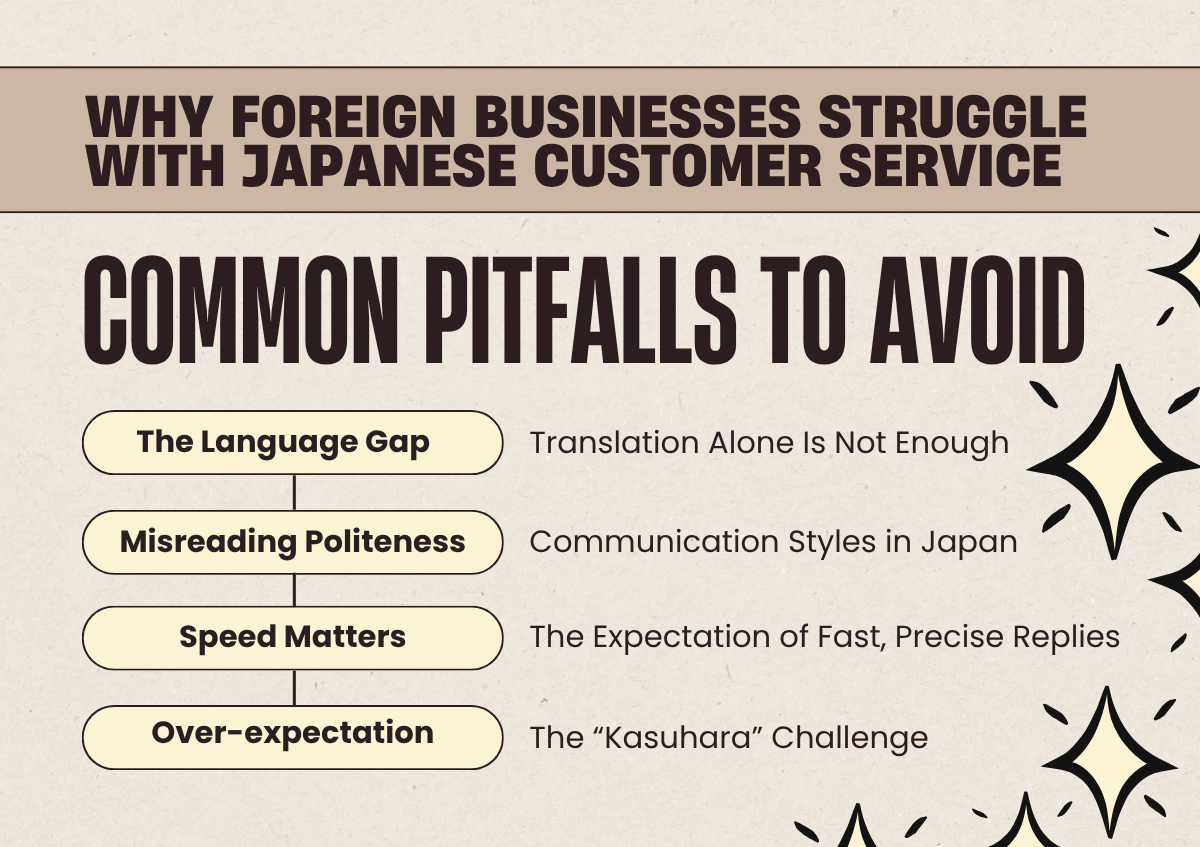
국내 시장에서 우수한 고객 서비스 평판을 가진 회사조차도 종종 일본에서 어려움을 겪습니다.문제는 노력 부족이 아니라 문화적 기대치의 격차입니다.일본 소비자들은 서비스 제공업체에 매우 높은 수준의 주의력, 공손함, 속도를 요구합니다.미국이나 유럽에서는 받아들일 수 있는 것으로 간주되는 것이 일본에서는 부주의하거나 심지어 무례한 것으로 보일 수 있습니다.
이 섹션에서는 국제 기업이 직면하는 가장 일반적인 문제를 강조하고 이를 방지하는 방법에 대한 지침을 제공합니다.
언어 격차: 번역만으로는 충분하지 않은 이유
단어 간 번역을 넘어서
많은 외국 기업들은 번역 에이전시를 고용하거나 이중 언어를 구사하는 직원을 고용하는 것만으로도 충분하다고 생각합니다.하지만 일본 커뮤니케이션에는 미묘한 차이가 있습니다.잘못된 단어나 예의 수준 (keigo) 을 선택하면 의도치 않게 고객이 멀어질 수 있습니다.예를 들어, “な” (고멘 나사이) 는 아무렇지 않게 들릴 수 있지만, “sumimasen” (sumimasen) 은 고객 서비스 환경에서는 좀 더 전문적으로 들릴 수 있습니다.
작문 스타일 및 브랜드 보이스
일본어는 각각 다른 의미를 가진 세 가지 문자 체계 (한자, 히라가나, 카타카나) 를 사용합니다.“I”와 같은 간단한 단어도,, 로 쓸 수 있는데, 각 단어마다 다른 어조 (격식, 부드러운 말, 캐쥬얼) 를 사용합니다.기계 번역이나 원어민이 아닌 작가는 브랜드 이미지와 충돌하는 버전을 선택할 수 있습니다.
미국과의 비교
미국에서는 어조가 중요하지만 메시지가 명확하고 간결하면 고객은 일반적으로 관대합니다.고객 서비스 센터에서는 가볍게 “죄송합니다”라는 말로도 충분할 수 있습니다.일본에서는 잘못된 표현 선택은 부주의함을 의미하며 신뢰를 떨어뜨릴 수 있습니다.
중소기업을 위한 테이크아웃
일본 원어민 카피라이터에 투자 및 지원 직원. 번역은 현지화가 아닙니다. 정확성, 뉘앙스, 문화적 조화는 신뢰를 구축하는 데 매우 중요합니다.
잘못 읽는 공손함: 일본의 커뮤니케이션 스타일
간접성과 비대결
일본 고객이 직접 불만을 제기하는 경우는 거의 없습니다.그 대신 단순히 서비스 사용을 중단하거나 네트워크 내에 부정적인 피드백을 조용히 퍼뜨릴 수도 있습니다.서구 기업의 입장에서 “불만 없음”처럼 느껴지는 것이 실제로는 불만을 나타내는 것일 수 있습니다.
사과와 겸손의 역할
일본에서는 진지한 사과가 보상보다 더 중요한 경우가 많습니다.즉시 책임을 지는 회사는 신뢰할 수 있는 회사로 여겨집니다.하지만 미국의 고객 서비스는 보통 문제 해결을 먼저 강조하고 예의상 사과를 덧붙입니다.
미국과의 비교
미국인들은 명확하고 직접적인 커뮤니케이션을 중시합니다.고객은 불만을 터놓고 털어놓으며 빠르고 실용적인 해결책을 기대하는 경우가 많습니다.이와는 대조적으로 일본 고객은 대립을 아예 피할 수 있기 때문에 직원이 미묘한 단서를 알아차리고 선제적으로 대응해야 합니다.
중소기업을 위한 테이크아웃
침묵이나 예의 바른 말을 불만의 잠재적 징후로 해석하도록 직원을 교육하세요.일본어로 사전 후속 이메일이나 전화를 걸면 고객 이탈을 방지할 수 있습니다.
속도가 중요합니다: 빠르고 정확한 답변에 대한 기대
신속성의 기준
일본에서는 응답 시간이 조금만 지연되어도 회사의 평판에 해를 끼칠 수 있습니다.고객은 표준 업무 시간 이외에도 문의가 신속하게 접수되기를 기대합니다.응답 속도는 신뢰성을 반영하는 것으로 간주되는 경우가 많습니다.
정밀도 및 디테일
일본 고객도 정확하고 완전한 답변을 기대합니다.응답이 모호하거나 부분적인 경우 완전한 해결책을 찾기 위해 조금 더 기다릴 때보다 좌절감을 느낄 수 있습니다.
미국과의 비교
미국 소비자들은 속도를 중시하지만 이러한 솔루션이 문제를 효율적으로 해결한다면 자동 응답이나 챗봇을 받아들이는 경우가 많습니다.자동화가 서서히 자리를 잡아가고 있긴 하지만 일본에서는 고객이 여전히 사람의 손길을 선호합니다.
중소기업을 위한 테이크아웃
전담 직원을 배치하여 일본어 지원 채널을 구축하세요.연중무휴 24시간 완전한 지원이 불가능하더라도 문화적으로 적절한 응답을 통해 신속하게 대응하십시오.
기대가 지나칠 때: '카스하라' 챌린지
카스하라의 이해
”카스하라” (“고객 괴롭힘”의 줄임말) 이란 고객이 “고객은 항상 옳다”는 사고 방식을 악용하여 무리한 요구를 하거나 직원을 학대하는 상황을 말합니다.이 문제는 최근 몇 년간 고객의 기대치가 계속 높아지면서 더욱 두드러졌습니다. 이에 따라 기업은 명확한 정책과 지원 시스템을 통해 직원을 보호하는 것이 필수적입니다.
더 트래디셔널 챌린지
지금까지 일본 기업들은 요구하거나 심지어 욕설적인 고객 행동을 용인해 왔으며, 종종 직원 복지보다 고객 만족을 우선시했습니다.그러나 노동력 부족이 심화되면서 괴롭힘 방지 정책과 구조화된 에스컬레이션 프로토콜을 통해 명확한 경계를 좁히는 기업이 늘어나고 있습니다.
미국과의 비교
미국의 기업에서는 종종 고객 욕설 행위에 대한 명확한 정책을 마련하여 계정을 해지하거나 서비스를 거부할 수 있습니다.일본 기업들은 최근에서야 유사한 조치를 취하기 시작했습니다.
중소기업을 위한 테이크아웃
욕설 고객을 처리하기 위한 명확한 내부 지침을 설정하여 일본인 직원을 보호하세요.일본에서 지속 가능한 운영을 구축하기 위해서는 고객 존중과 직원 보호 사이의 균형이 점점 더 중요해질 것입니다.
SME가 일본에서 성공하는 고객 서비스를 구축하는 방법
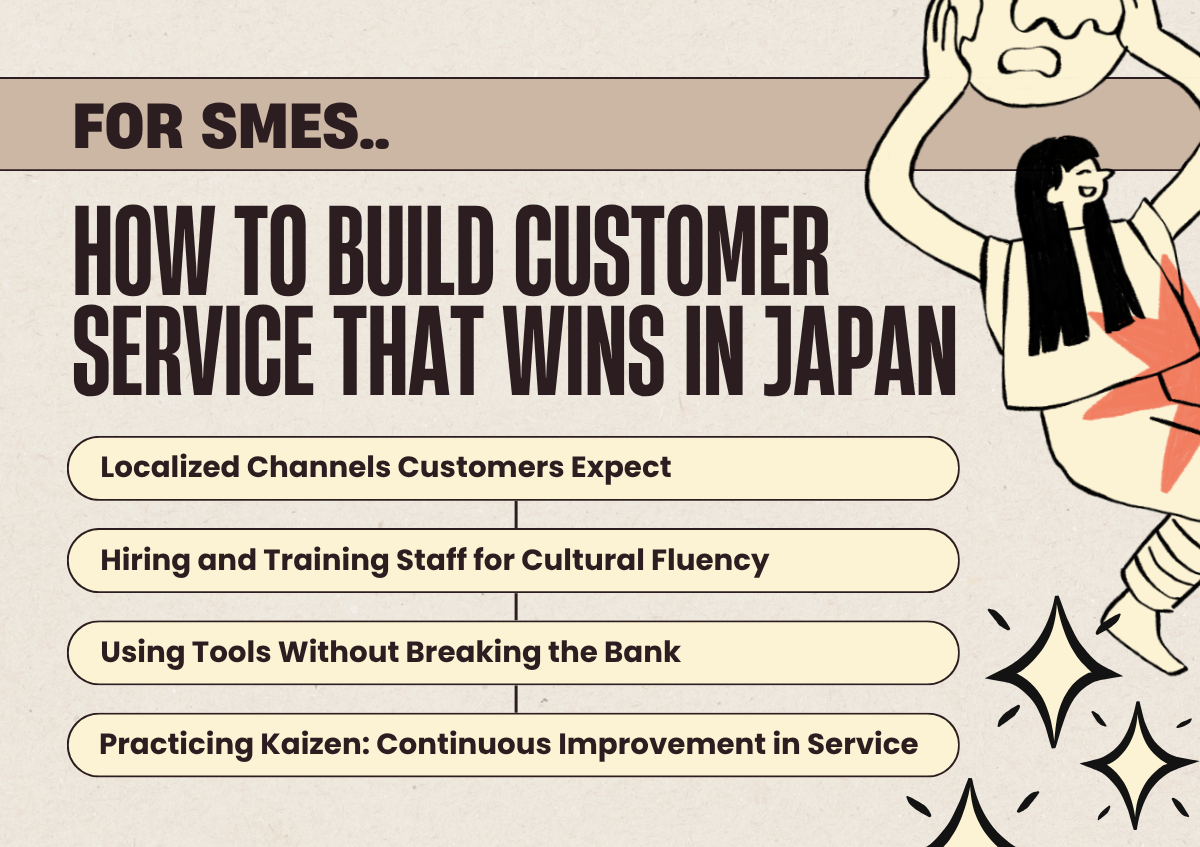
중소기업은 대기업만이 일본 소비자가 기대하는 유형의 고객 서비스를 제공할 수 있다고 생각하는 경우가 많습니다.실제로 중소기업은 제한된 리소스로도 충성도와 신뢰를 얻는 서비스 문화를 구축할 수 있습니다.핵심은 일본인의 선호도에 적응하고, 직원이 언어를 유창하게 구사하는 수준을 넘어설 수 있도록 교육하고, 기술을 효과적으로 활용하고, 지속적인 개선을 위해 최선을 다하는 데 있습니다.
고객이 기대하는 현지화된 채널
일본 소비자들은 친숙하고 신뢰할 수 있는 채널을 통해 비즈니스에 접근하기를 기대합니다.여전히 많은 중소기업이 전화와 이메일을 주로 사용하는 미국과 달리 일본 고객은 메시징 플랫폼과 모바일 우선 솔루션을 선호하는 경우가 많습니다.
전화 지원: 일본에서는 여전히 필수
디지털 채널의 등장에도 불구하고 일본 고객에게는 여전히 전화 지원이 협상 대상이 아닙니다..효과적인 상호작용을 위해서는 명확한 의사소통, 적극적인 경청, 예의 바른 어조가 필수적입니다.미국에서는 고객이 더 짧고 거래량이 많은 전화 통화를 받는 경우가 많습니다.일본에서는 직원이 주의 깊게 듣고 철저하게 응답해야 하기 때문에 통화가 더 오래 걸릴 수 있습니다.
LINE: 일본의 메시징 표준
미국 기업들은 빠른 고객 응대를 위해 페이스북 메신저 또는 SMS를 사용하는 경우가 많지만, 일본에서는 LINE이 주요 메시징 앱입니다.LINE을 통해 고객 서비스를 제공하는 것은 혁신이라기보다는 기본적인 기대로 여겨지는 경우가 많습니다.주문 업데이트, 문의 등을 위해 LINE을 도입한 중소기업 프로모션 일본 시장에 서비스를 제공하겠다는 약속을 보여줍니다.
이메일과 채팅: 세련된 답변의 중요성
일본 소비자들은 이메일에서 체계적이고 정중하며 상세한 답변을 기대합니다.짧고 가벼운 답장이 허용되는 미국과 달리 일본 이메일은 엄격한 에티켓과 형식 지정 규칙을 따르는 경우가 많습니다.실시간 채팅도 인기를 얻고 있지만 속도와 형식 사이에서 균형을 유지해야 합니다.
문화적 유창성을 위한 직원 채용 및 교육
언어 능력만으로는 일본어 고객 서비스에서 성공할 수 없습니다.직원들은 고객과의 상호작용에 영향을 미치는 문화적 기대치, 커뮤니케이션 스타일, 친절함의 뉘앙스를 이해해야 합니다.
이중 언어주의를 넘어서
일본으로 사업을 확장하는 미국 기업은 이중 언어를 구사하는 직원을 우선시하는 경우가 많지만, 언어 능력에 너무 집중하면 가용 인력이 제한될 수 있습니다.일반적으로 문화적으로 유창한 것이 더 중요합니다.서비스 기대치를 철저하게 이해하는 일본 원어민 직원은 문화적 인식이 부족한 이중 언어 구사자보다 성과가 좋은 경우가 많습니다.
커뮤니케이션 교육
미국에서는 서비스 교육을 통해 친절함과 효율성을 강조하는 경우가 많습니다.일본에서는 교육에 반드시 케이고 (존칭 언어), 적극적인 경청, 적절한 형태의 사과 등이 포함되어야 합니다.예를 들어, 비즈니스 상황에서는 “고멘 나사이”보다 “스미마센”이 더 적합한 경우가 많은데, 이는 외국인 직원들에게 반드시 가르쳐야 한다는 뉘앙스입니다.
채용 차이: 미국 대 일본
- 미국 채용은 종종 개성, 과거 업적 및 적극적인 성격에 대한 보상을 제공합니다.
- 일본인 채용은 그룹 조화, 계층 존중, 장기적인 충성도를 중시합니다.
SME의 경우 채용 시 팀워크와 인내심을 강조하는 것이 순전히 “실력 있는” 프로필을 찾는 것보다 더 효과적일 수 있습니다.
큰 비용을 들이지 않고 도구 사용하기
SME는 고품질 서비스를 제공하기 위해 기업 규모의 예산이 필요하지 않습니다.저렴한 도구를 적절히 조합하면 제한된 직원 수용력과 높은 고객 기대치 사이의 격차를 해소할 수 있습니다.
중소기업을 위한 CRM 시스템
미국 기업은 Salesforce와 같은 대규모 플랫폼을 채택하는 경우가 많지만 일본 중소기업은 LINE 또는 이메일과 통합되는 가볍고 저렴한 CRM을 활용할 수 있습니다.Zoho 또는 HubSpot Starter 플랜과 같은 옵션을 통해 SME는 큰 비용 없이 문의를 관리하고 고객 기록을 추적할 수 있습니다.
챗봇 및 자동화
미국에서는 챗봇이 기본적인 문의 시 인적 상호 작용을 대체하는 데 널리 사용됩니다.일본에서는 자동화가 인적 요소를 대체하는 것이 아니라 향상시켜야 합니다.초기 질문을 처리하지만 복잡한 문제를 상담원에게 신속하게 라우팅하는 챗봇은 신뢰를 유지하면서 효율성을 개선할 수 있습니다.
기술 채택률
- 미국: 효율성에 중점을 둔 AI 기반 지원 도구의 신속한 채택.
- 일본: 공감과 인간적 접촉을 유지하는 데 중점을 두어 채택 속도가 느립니다.중소기업은 단순히 미국 관행을 수입하는 것이 아니라 일본의 문화적 기대에 부합하는 방식으로 도구를 조정해야 합니다.
카이젠 실천: 지속적인 서비스 개선
일본의 고객 서비스는 “설정하고 잊어버리는” 기능이 아닙니다.성공을 위해서는 카이젠의 철학에 뿌리를 둔 원칙인 끊임없는 개선이 필요합니다.
Kaizen이 고객 서비스에 미치는 영향
카이젠 (Kaizen), 즉 지속적 개선은 시간이 지나면서 복합되는 작고 일관된 변화를 장려합니다.중소기업의 책임은 다음과 같습니다.
- 매주 고객 피드백을 검토하고 프로세스를 조정합니다.
- 서비스 과제에 대해 정기적으로 직원 토론을 개최합니다.
- 일선 직원이 개선 사항을 제안할 수 있도록 권한을 부여합니다.
PDCA 사이클의 실제 사례
많은 일본 기업은 서비스 운영에 계획-실행-점검법 (PDCA) 사이클을 적용합니다.예를 들면 다음과 같습니다.
- 계획: 불만 처리를 위한 새로운 스크립트를 제안하세요.
- 해야 할 일: 고객과 함께 테스트해 보십시오.
- 확인: 피드백을 수집하고 만족도를 측정하세요.
- 조치: 최상의 접근 방식을 표준화하십시오.
미국의 접근법과의 비교
미국에서는 분기별 KPI 또는 고객 만족도 조사를 통해 서비스 개선을 주도하는 경우가 많습니다.일본에서는 점진적이고 직원 중심적인 태도로 초점을 맞추고 있으며, 모든 직원이 고객 경험을 개선할 방법을 찾도록 장려하고 있습니다.
산업별 일본 고객 서비스를 위한 실용 플레이북

일본 고객 서비스 기대치는 업계에 따라 다르지만, 고객의 요구를 신중하고 성실하게 예측하는 오모테나시의 기본 원칙은 변함이 없습니다.일본에 진출하는 외국 중소기업의 경우 부문별 맞춤형 서비스 전략을 수립하는 것이 필수적입니다.다음은 기업이 일본 표준을 준수하고 미국의 서비스 모델과 유용한 대조를 이룰 수 있도록 돕는 실용적인 접근 방식입니다.
전자 상거래: 일본 정밀도를 통한 반품 및 문의 처리
일본에서는 온라인 쇼핑이 번창하고 있지만 고객 서비스에 대한 기대치는 대부분의 서구 시장보다 훨씬 엄격합니다.
원활한 반품 및 교환
미국에서는 고객이 14~30일의 반품 기간을 허용하는 경우가 많으며, 반품 배송비를 구매자에게 전가하기도 합니다.일본에서는 고객의 부담을 최소화하면서 번거롭지 않은 반품을 제공할 것으로 기대하는 경우가 많습니다. 소규모 전자 상거래 브랜드도 신속하고 정중하게 거래소를 처리할 것으로 예상됩니다.
주문에 대한 명확한 커뮤니케이션
일본 고객은 사전 업데이트를 중요하게 생각합니다.상세한 사과와 수정된 배송 일정이 포함된 지연 이메일은 일반적인 “주문이 지연되고 있다”는 것보다 훨씬 더 고객을 안심시킬 수 있습니다.미국에서는 고객이 일반적으로 속도와 업데이트 추적에 초점을 맞추는 반면, 일본에서는 어조, 격식, 사과가 똑같이 중요합니다.
권장 사항의 개인화
장소: 미국 전자 상거래 회사는 종종 광범위한 알고리즘 기반 제안에 의존합니다., 일본 소비자들은 주의를 기울이는 엄선된 정확한 권장 사항에 잘 반응합니다.예를 들어, 과거에 구매한 제품을 바탕으로 보완적인 제품을 제안하는 것은 거슬리지 않고 사려 깊은 것으로 여겨지는 경우가 많습니다.
여행 및 호스피탈리티: 재방문자를 창출하는 개인화
일본의 호스피탈리티 산업은 오모테나시를 중심으로 세계적으로 유명합니다.이 분야의 중소기업에게는 고객과의 모든 상호 작용이 충성도를 높일 수 있는 기회입니다.맞춤형 인사말부터 사전 예방적 문제 해결에 이르기까지 작은 제스처가 일회성 방문자와 단골 고객 간의 차이를 만드는 경우가 많습니다.
게스트 요구 사항 예측
미국의 숙박업에서는 셀프 체크인 키오스크 또는 모바일 앱 서비스와 같이 편의성을 강조하는 경우가 많습니다.일본에서는 이러한 기술이 존재하지만 여전히 휴먼 터치를 높이 평가합니다.손님의 이름을 부르며 인사를 하거나, 도착 시 슬리퍼를 제공하거나, 이전에 방문했던 식단 제한 사항에 대해 언급하면 한 번 방문한 손님이 재방문으로 바뀔 수 있습니다.
사려 깊은 제스처
예를 들면 환영 선물, 손으로 쓴 메모, 생일에 보내는 작은 서프라이즈 등이 있습니다.미국 호텔에서는 로열티 프로그램과 포인트 제도에 초점을 맞출 수 있지만, 일본 호텔에서는 진정한 배려를 보여주는 기억에 남을 만한 맞춤형 순간을 만드는 데 중점을 둡니다.
사과와 후속 조치의 힘
투숙 중에 문제가 생겼을 때, 때로는 작은 선물이나 서비스 복구 조치와 함께 진심으로 사과하는 것이 큰 도움이 됩니다.미국에서는 보상 (바우처나 할인 등) 이 주된 접근 방식인 반면, 일본에서는 물질적 배상만큼이나 어조와 진실성이 중요합니다.
금융 및 핀테크: 명확성과 보안을 통한 신뢰 구축
일본의 금융 부문은 특별한 도전에 직면해 있습니다. 고객은 보수적이고 위험을 회피하는 경향이 있습니다. 신뢰를 가장 중요한 요소로.
커뮤니케이션의 명확성
핀테크 앱이 캐주얼하고 친근한 언어를 사용하는 경우가 많은 미국과 달리 일본 소비자는 공식적이고 정확한 설명을 기대합니다.지나치게 캐주얼한 커뮤니케이션은 신뢰가 전부인 분야에서 신뢰를 떨어뜨릴 수 있습니다.
보안 및 투명성
일본 소비자는 많은 미국 고객보다 금융 보안을 더 면밀히 조사합니다.데이터 보호, 사기 예방 및 분쟁 처리에 대한 자세한 정보를 제공하는 것은 필수적입니다.중소기업 핀테크는 안전 조치를 알기 쉬운 일본어로 명확하고 정중하게 전달함으로써 차별화할 수 있습니다.
휴먼 터치를 디지털 서비스로 구축
미국에서는 핀테크가 인간의 상호작용을 최소화하는 데 자부심을 느끼는 경우가 많습니다.일본에서는 디지털 도구와 함께 접근 가능한 인적 지원을 통해 고객을 안심시킬 수 있습니다.예를 들어 예의 바르고 문화적으로 유창한 직원이 있는 헬프라인을 제공하면 새 앱에 대한 신뢰도를 크게 높일 수 있습니다.
기술 및 전자: 고품질 제품에 맞는 지원
일본의 기술 및 전자 시장은 경쟁이 치열하며 품질에 의해 주도됩니다.기술을 판매하거나 지원하는 중소기업의 경우 고객 서비스가 제품의 품질과 일치해야 합니다.
자세한 설명서 및 가이드
미국 사용자는 빠른 시작 설명서와 짧은 비디오 자습서를 기대하는 반면, 일본 소비자는 여러 시나리오를 다루는 심층적인 단계별 가이드를 선호합니다.간결함보다 명확성과 완전성을 중시합니다.
다국어 및 연중무휴 지원
일본에는 국내외 기술 사용자가 많기 때문에 다국어 지원 및 연중무휴 액세스를 제공하는 회사가 눈에 띕니다.미국에서는 연중무휴 지원이 기업 수준의 서비스인 경우가 많지만, 일본에서는 SME에서도 이를 제공할 것으로 기대되거나 최소한 대응 능력이 뛰어난 것으로 점점 더 기대되고 있습니다.
원격 문제 해결
소비자들은 꼭 필요한 경우가 아니면 제품을 반품할 필요 없이 신속하고 정확한 해결을 기대하는 일본에서 원격 지원을 매우 중요하게 생각합니다.미국의 경우 고객은 수리 또는 교체를 위해 결함이 있는 제품을 우편으로 보내는 것을 더 관대할 수 있습니다.이와 반대로 일본 소비자들은 이러한 과정을 불필요한 불편으로 간주하여 브랜드 신뢰도를 떨어뜨리는 경우가 많습니다.
일본 고객 서비스에 투자하는 것이 효과가 있는 이유: 비즈니스 사례
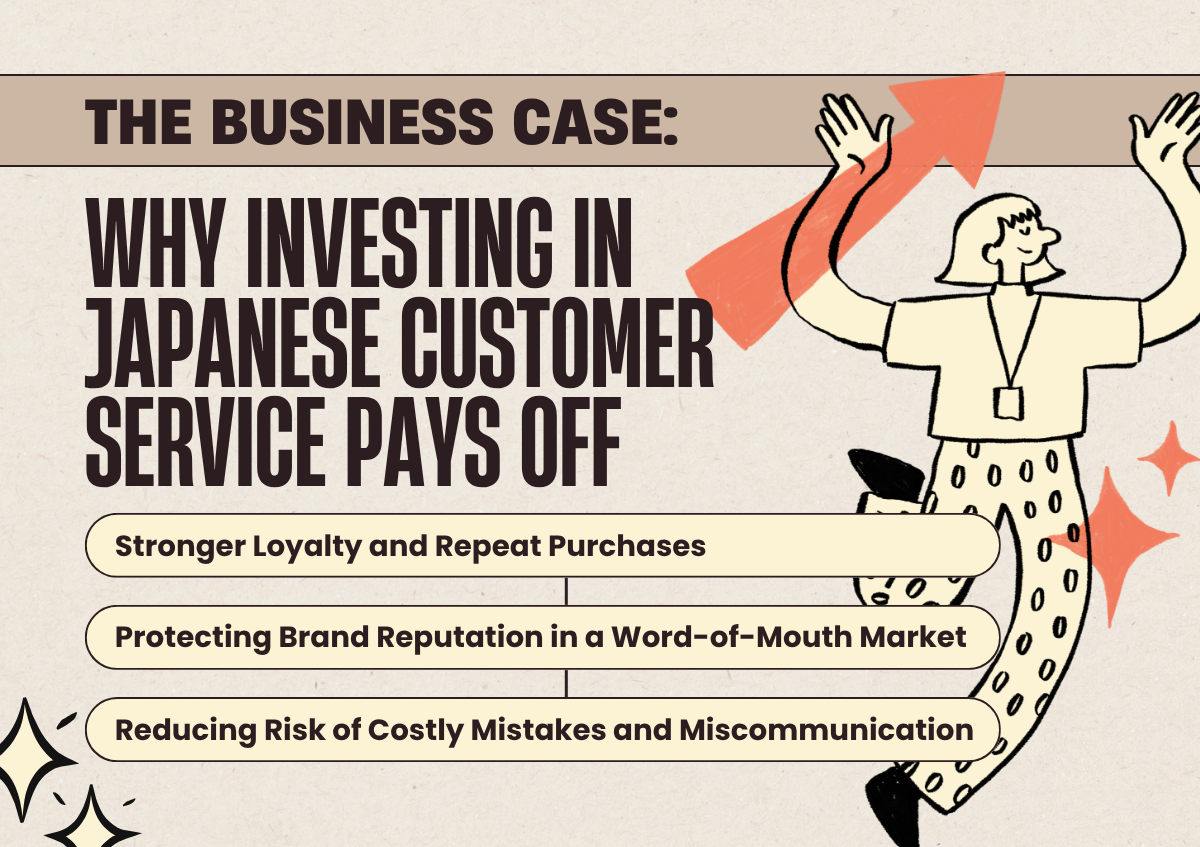
많은 국제 기업에서 일본은 높은 기준으로 인해 어려운 시장으로 인식되고 있습니다.그러나 이러한 기준 때문에 고객 서비스에 대한 투자는 현존하는 가장 높은 투자수익률 (ROI) 전략 중 하나입니다.가격 경쟁력이나 제품 혁신이 지배적인 경우가 많은 미국과 달리 일본 소비자들은 세심한 배려와 명확성, 신뢰성을 제공하는 브랜드를 꾸준히 칭찬합니다.이 섹션에서는 일본에서 서비스에 자원을 투자하는 것이 단순히 비용이 아니라 성장 배가인 이유를 살펴봅니다.
충성도 및 반복 구매 강화
일본의 고객 서비스는 충성도에 직접적인 영향을 미치며 외국 기업은 종종 놀라움을 금치 못합니다.
평생 가치의 차이
미국에서는 로열티 프로그램과 할인으로 인해 반복 구매가 자주 발생합니다.하지만 일본에서는 신뢰, 신뢰성, 세심함을 통해 충성도를 얻을 수 있습니다.“보살핌을 받고 있다”고 느끼는 고객은 다시 구매할 가능성이 높을 뿐만 아니라 더 저렴한 대안이 있더라도 수년 동안 브랜드 충성도를 유지하는 경우가 많습니다.
예: 시련에서 습관으로
한 글로벌 스킨케어 브랜드는 현지 고객 지원 팀과 상담한 일본 고객이 온라인으로만 쇼핑한 고객보다 반복 구매를 할 확률이 40% 더 높다는 사실을 발견했습니다.정중한 후속 이메일, 투명한 반품 절차, 제품 지침은 한 번 구입한 구매자를 평생 팬으로 전환시키는 신뢰 고리를 구축했습니다.
입소문 시장에서의 브랜드 평판 보호
일본에서는 입소문이 큰 영향을 미칩니다, 온라인 및 오프라인 모두리뷰가 양극화될 수 있지만 양에 따라 금세 빠져나가는 미국과 달리 일본 소비자는 개인적인 추천과 상세한 리뷰에 무게를 두는 경향이 있습니다.
부정적인 피드백은 더 긴 결과를 초래합니다
한 가지 해결되지 않은 문제가 파급될 수 있습니다 소셜 미디어 전반에서, 비교 블로그 및 포럼일본 고객은 완벽한 서비스를 기대하기 때문에 눈에 띄는 실수는 미국보다 복구하기가 더 어렵습니다.사전 예방적 문제 해결은 손해 방지뿐 아니라 브랜드 보험입니다.
칭찬의 효과를 증폭시키다
긍정적인 경험은 부정적인 경험만큼 큰 영향을 미칠 수 있습니다.진정으로 존중받는다고 느끼는 고객은 가족, 친구 또는 커뮤니티 그룹과 이야기를 나누는 경우가 많습니다.긴밀하게 연결된 일본의 소비자 네트워크에서는 이러한 옹호가 그 어느 때보다 중요합니다. 전통적인 광고 브랜드 평판을 크게 높일 수 있습니다.
비용이 많이 드는 실수 및 잘못된 의사소통의 위험 감소
일본에서의 고객 서비스는 만족뿐만 아니라 위험 관리도 중요합니다.세부 사항이 중요하고 정확해야 하는 일본에서는 다른 곳에서는 용서받을 수 있는 오해가 용납되지 않습니다.
위험 완화로서의 언어 정밀도
미국에서는 제품 설명서의 작은 문구 실수를 무시할 수 있습니다.일본에서도 같은 실수로 제품 반품, 평판 하락, 심지어 규제 불만이 발생할 수 있습니다. 모국어 직원과 정확한 번역에 투자하면 이러한 위험을 최소화할 수 있습니다.
규정 준수 및 문화적 민감성
핀테크 또는 의료 분야를 고려해 보십시오. 약관, 수수료 또는 절차에 대한 오해가 빠르게 확대될 수 있습니다.일본 전담 지원팀은 외국 기업이 비용이 많이 드는 오류, 규제 처벌 또는 PR 위기를 피할 수 있도록 도와줍니다.
결론: 고객 서비스를 통한 일본에서의 장기적 성공 구축
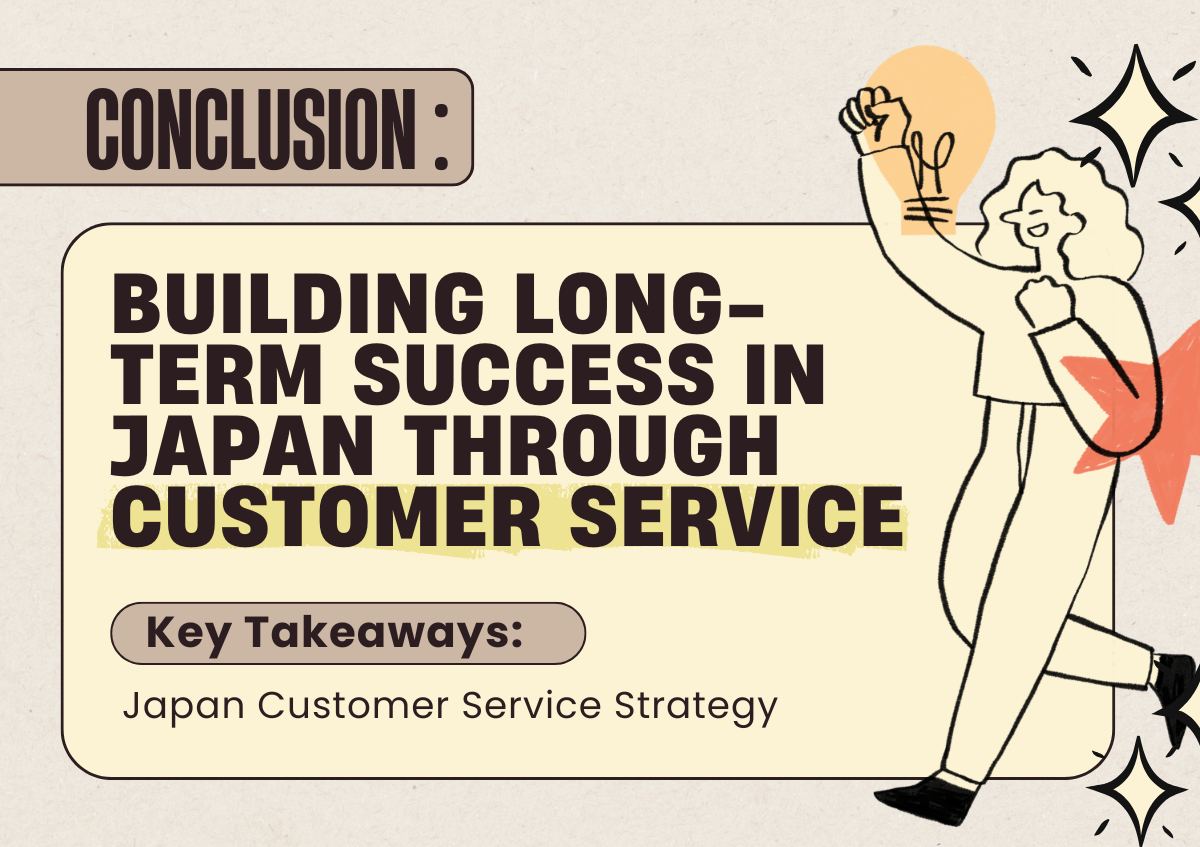
일본에서 성공하기 위해 중소기업이 일본의 모든 비즈니스 관행을 모방할 필요는 없지만, 고객이 있는 곳에서 고객을 만나겠다는 진정한 헌신이 필요합니다.문화적 이해, 현지화된 커뮤니케이션, 지속적인 개선에 투자함으로써 소규모 기업도 일본 소비자에게 깊은 인상을 남기는 서비스 수준을 달성할 수 있습니다.
오랜 기간 머무르는 충성도 높은 고객, 유기적 성장을 이끌어내는 브랜드 평판, 정확성과 성실성을 중시하는 시장에서 실수 위험이 줄어든다는 점에서 상당한 보상이 따릅니다.일본의 높은 기준은 처음에는 부담스러워 보일 수 있지만, 기꺼이 적응하려는 기업에게는 그 역할도 합니다. 지속 가능한 성공을 위한 로드맵.
주요 내용: 일본 고객 서비스 전략
- 일본의 고객 서비스는 단순한 거래적 현상이 아니라 문화적 현상입니다.오모테나시 (진심 어린 환대), 키쿠바리 (무언의 필요를 예상하는 것), “고객은 신이다”라는 사고방식과 같은 개념은 많은 해외 기업에 익숙한 수준을 능가하는 관리 표준을 확립합니다.작은 제스처라도 일관되게 전달하면 브랜드를 차별화할 수 있습니다.
- 제품 자체만큼이나 언어와 뉘앙스가 중요합니다. 번역만으로는 충분하지 않습니다. 고객은 단어 선택, 어조 및 공손한 태도를 알아차립니다.원어민을 고용하고, 적절한 keigo (경어) 를 사용하고, 브랜드 보이스를 현지화하는 것은 신뢰를 구축하는 데 있어 중요한 단계입니다.
- 공손함은 종종 불만을 숨깁니다.미국과 달리 일본 고객은 직접 불만을 제기하는 경우가 거의 없습니다.조용하거나 지나치게 예의 바른 피드백은 문제를 나타낼 수 있습니다.고객 이탈을 방지하려면 사전에 후속 조치를 취하고 미묘한 단서에 주의를 기울이는 것이 중요합니다.
- 속도와 정확도는 타협의 대상이 아닙니다.고객은 즉각적인 인정과 상세하고 정확한 답변을 기대합니다.미국 소비자는 자동 응답이나 부분적 해결을 용인할 수 있지만 일본 소비자는 대응력과 완벽함의 조화를 높이 평가합니다.
- 높은 기대는 “카스하라”로 이어질 수 있습니다.일부 고객은 다음과 같은 이점을 활용할 수 있습니다. 서비스 우선 문화 불합리한 요구와 함께명확한 에스컬레이션 프로토콜과 괴롭힘 방지 지침으로 직원을 보호하는 것은 고객에게 서비스를 제공하는 것만큼이나 중요합니다.
- 산업별로 접근 방식을 조정하세요.
- 전자 상거래: 번거롭지 않은 반품, 사전 업데이트, 맞춤형 제품 제안이 일반적입니다.
- 호스피탈리티: 작고 사려 깊은 제스처가 로열티 포인트나 앱보다 더 중요합니다.
- 금융 및 핀테크: 공식적인 명확성, 보안 투명성, 인적 지원에 대한 접근성은 신뢰를 구축합니다.
- 기술 및 전자: 철저한 문서화, 다국어 지원 및 원격 문제 해결이 필요합니다.
- SME도 스마트하게 적응하면 경쟁할 수 있습니다.기업 수준의 예산은 필요하지 않습니다.LINE 지원을 제공하고, 간단한 CRM 도구에 투자하고, 직원에게 문화에 대한 유창한 교육을 제공하면 과도한 리소스 없이도 상당한 효과를 거둘 수 있습니다.
- 지속적인 개선은 우리 문화의 필수적인 부분입니다.일본의 카이젠 원칙은 서비스가 끊임없이 발전해야 한다는 것을 의미합니다.피드백을 정기적으로 검토하고, 직원이 변경 사항을 제안할 수 있도록 권한을 부여하고, 프로세스를 개선하면 귀사가 고객 못지않게 진행 상황에도 관심을 갖고 있다는 것을 고객에게 알릴 수 있습니다.
- ROI는 진짜입니다.강력한 서비스는 장기적인 충성도로 이어지고, 입소문이 주도하는 시장에서 브랜드를 보호하며, 잘못된 의사소통으로 인한 비용이 많이 드는 실수를 줄여줍니다.일본에서 서비스 우수성은 단순한 비용 중심이 아니라 경쟁 우위이자 성장의 핵심 동력입니다.
일본에서 비즈니스에 활기를 불어넣으세요!
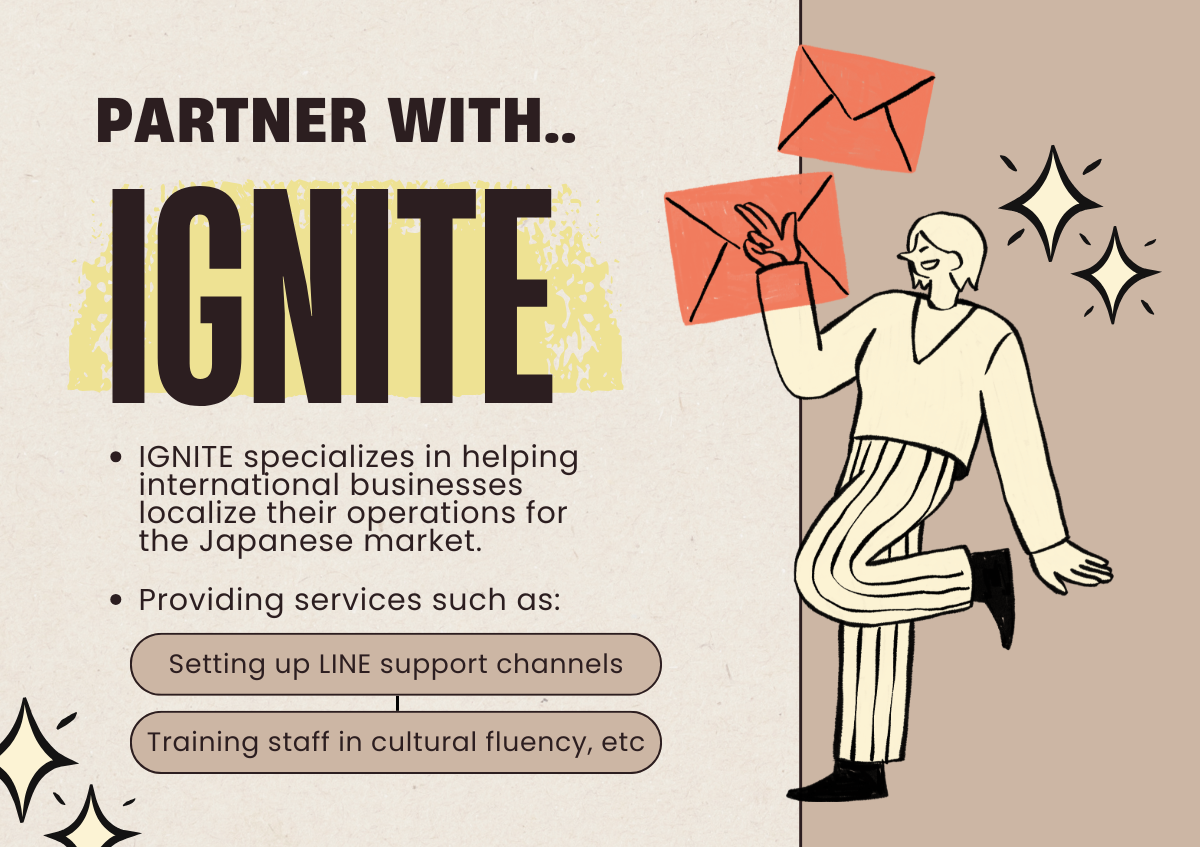
고객 서비스 전략을 일본의 세계적 수준으로 끌어올릴 준비가 되셨나요?IGNITE는 국제 기업이 일본 시장을 대상으로 사업을 현지화할 수 있도록 지원하는 것을 전문으로 합니다.LINE 지원 채널 구축부터 직원의 문화적 유창성 및 편의성 교육에 이르기까지 기업 수준의 예산 없이도 고객의 기대를 뛰어넘는 데 필요한 도구와 전문 지식을 제공합니다.
우리와 협력하여 비용이 많이 드는 실수를 방지하십시오. 시장 진입을 가속화하세요일본 고객과의 지속적인 신뢰를 구축하십시오.
지금 IGNITE에 연락하여 여정을 시작하세요 일본에서의 서비스 우수성을 지향합니다.

















